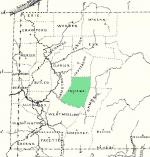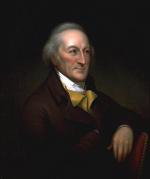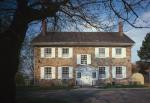![header=[Marker Text] body=[Formed March 30, 1803 from Westmoreland and Lycoming counties, and once densely forested. Its name memorializes the first inhabitants. County seat, Indiana, was laid out in 1805 on land given by George Clymer, signer of the Declaration of Independence. ] sign](http://explorepahistory.com/kora/files/1/10/1-A-272-139-ExplorePAHistory-a0h8v6-a_450.jpg)
Mouse over for marker text
Name:
Indiana County [George Clymer]
Region:
Laurel Highlands/Southern Alleghenies
County:
Indiana
Marker Location:
New Courthouse Sq., 8th and Philadelphia Sts., Indiana
Dedication Date:
September 10, 1982
Behind the Marker
George Clymer was one of the few founding fathers to sign the Declaration of Independence, the Articles of Confederation, and the Federal Constitution. A leading Philadelphia merchant, he used his commercial expertise to combat the financial problems of the Confederation government.
Orphaned in 1740, only a year after his birth in Philadelphia, Clymer was raised, educated, and apprenticed to the mercantile business by a wealthy uncle, Quaker merchant William Coleman. The youngster demonstrated great promise as he advanced from clerk to full-fledged partner in his uncle's mercantile firm. After his uncle's death, Clymer merged operations with the Merediths, a prominent Philadelphia business family, and cemented the relationship by marrying his senior partner's daughter, Elizabeth, in 1765.
When tensions between the colonies and Great Britain escalated in the early 1770s, Clymer became angered by the economic restrictions on his business. One of the first Pennsylvanians to recommend independence, he served on the Pennsylvania Council of Safety, and, in 1773, headed a committee that forced the resignation of Philadelphia tea consignees appointed by Britain under the Tea Act. Channeling his considerable energies into financial matters, Clymer in 1775-76 served as one of the first two Continental treasurers, and helped underwrite the war by exchanging all of his own specie for Continental currency.
Quiet and unassuming in person, Clymer rarely spoke in the proceedings of the Continental Congress, in which he served two terms, 1776-77 and 1780-82. Instead, he made his contributions as a member of the commerce, finance, and military affairs committees. He also signed both the Declaration of Independence and the Articles of Confederation. When Congress fled from Philadelphia in December 1776, Clymer remained behind with George Walton and Robert Morris to conduct congressional business. The following year, after the British victory at the
Robert Morris to conduct congressional business. The following year, after the British victory at the  Battle of Brandywine, Redcoat troops advancing on Philadelphia detoured to vandalize his home in Chester County, about twenty-five miles outside the city. His wife and children hid nearby in the woods.
Battle of Brandywine, Redcoat troops advancing on Philadelphia detoured to vandalize his home in Chester County, about twenty-five miles outside the city. His wife and children hid nearby in the woods.
After the war, Clymer served in the Pennsylvania legislature from 1784 to 1788. There he advocated a bicameral legislature, reform of the penal code, and end of capital punishment. At the Constitutional Convention of 1787, Clymer rarely spoke, but he did play a modest role in shaping the final document, which also bears his signature.
Clymer then served in the U.S. House of Representatives in the First Congress (1789-91), and as a collector of the much detested excise taxes on alcoholic beverages in Pennsylvania (1791-94). In 1795-96 he sat on the presidential commission that negotiated a treaty with the Cherokee and Creek Indians in Georgia. It was during this time that he resided at Summerseat, a two-story Georgian mansion along the banks of the Delaware River in Bucks County that had previously belonged to Robert Morris.
Summerseat, a two-story Georgian mansion along the banks of the Delaware River in Bucks County that had previously belonged to Robert Morris.
After he retired from politics, Clymer advanced various community projects, including the Philadelphia Society for Promoting Agriculture and the Pennsylvania Academy of the Fine Arts, and served as the first president of the Philadelphia Bank. Like many other contemporaries, Clymer also speculated in western lands, and donated the land upon which the town of Indiana was laid out in the early 1800s. He died at Summerseat, in 1813 at the age of seventy-three. He is buried in the Friends Meeting House Cemetery at Trenton, New Jersey.
Pennsylvania Academy of the Fine Arts, and served as the first president of the Philadelphia Bank. Like many other contemporaries, Clymer also speculated in western lands, and donated the land upon which the town of Indiana was laid out in the early 1800s. He died at Summerseat, in 1813 at the age of seventy-three. He is buried in the Friends Meeting House Cemetery at Trenton, New Jersey.
Orphaned in 1740, only a year after his birth in Philadelphia, Clymer was raised, educated, and apprenticed to the mercantile business by a wealthy uncle, Quaker merchant William Coleman. The youngster demonstrated great promise as he advanced from clerk to full-fledged partner in his uncle's mercantile firm. After his uncle's death, Clymer merged operations with the Merediths, a prominent Philadelphia business family, and cemented the relationship by marrying his senior partner's daughter, Elizabeth, in 1765.
When tensions between the colonies and Great Britain escalated in the early 1770s, Clymer became angered by the economic restrictions on his business. One of the first Pennsylvanians to recommend independence, he served on the Pennsylvania Council of Safety, and, in 1773, headed a committee that forced the resignation of Philadelphia tea consignees appointed by Britain under the Tea Act. Channeling his considerable energies into financial matters, Clymer in 1775-76 served as one of the first two Continental treasurers, and helped underwrite the war by exchanging all of his own specie for Continental currency.
Quiet and unassuming in person, Clymer rarely spoke in the proceedings of the Continental Congress, in which he served two terms, 1776-77 and 1780-82. Instead, he made his contributions as a member of the commerce, finance, and military affairs committees. He also signed both the Declaration of Independence and the Articles of Confederation. When Congress fled from Philadelphia in December 1776, Clymer remained behind with George Walton and
After the war, Clymer served in the Pennsylvania legislature from 1784 to 1788. There he advocated a bicameral legislature, reform of the penal code, and end of capital punishment. At the Constitutional Convention of 1787, Clymer rarely spoke, but he did play a modest role in shaping the final document, which also bears his signature.
Clymer then served in the U.S. House of Representatives in the First Congress (1789-91), and as a collector of the much detested excise taxes on alcoholic beverages in Pennsylvania (1791-94). In 1795-96 he sat on the presidential commission that negotiated a treaty with the Cherokee and Creek Indians in Georgia. It was during this time that he resided at
After he retired from politics, Clymer advanced various community projects, including the Philadelphia Society for Promoting Agriculture and the







